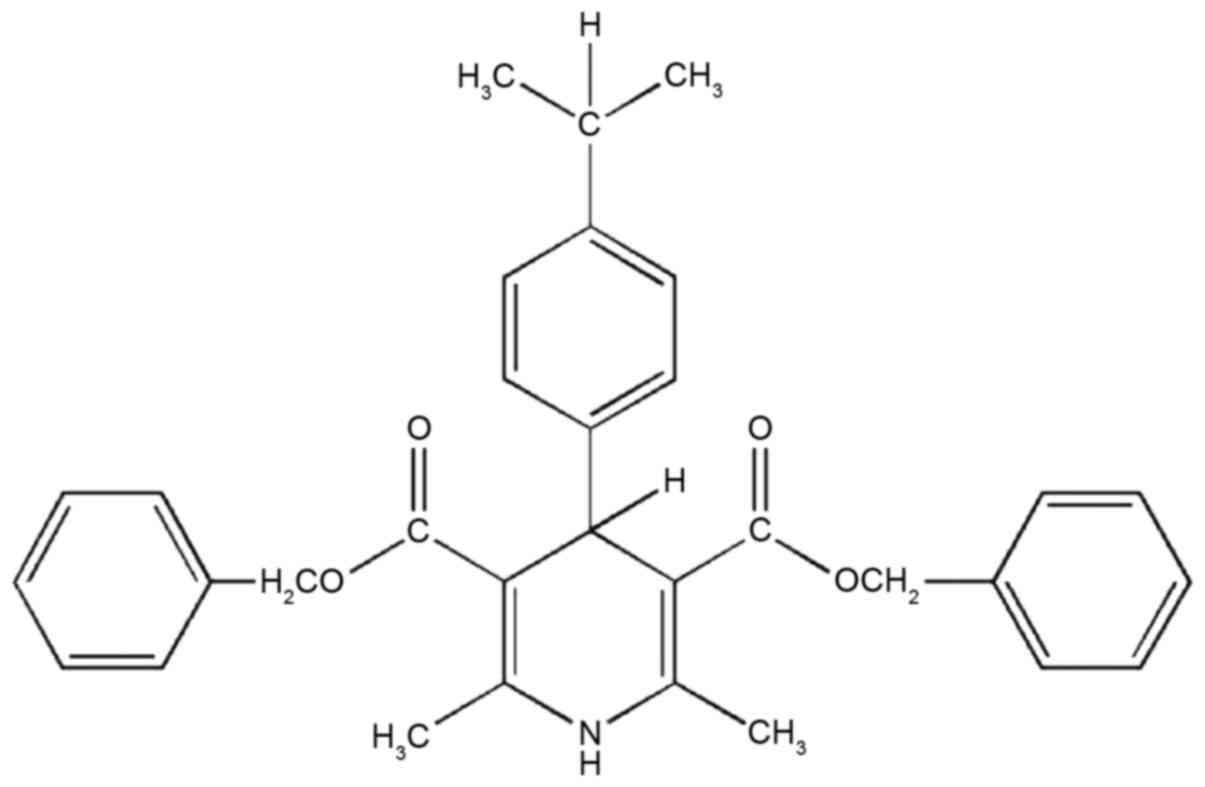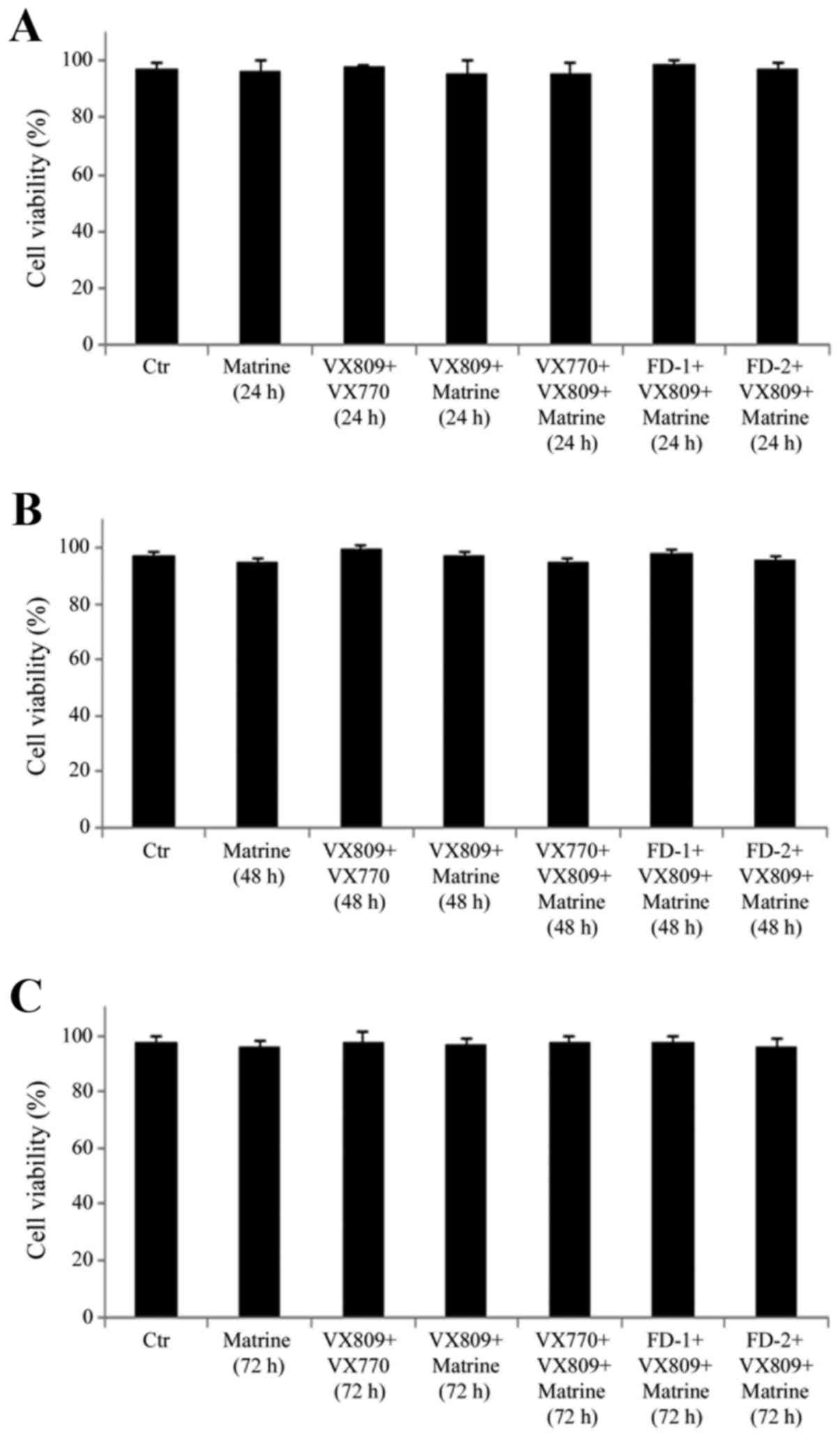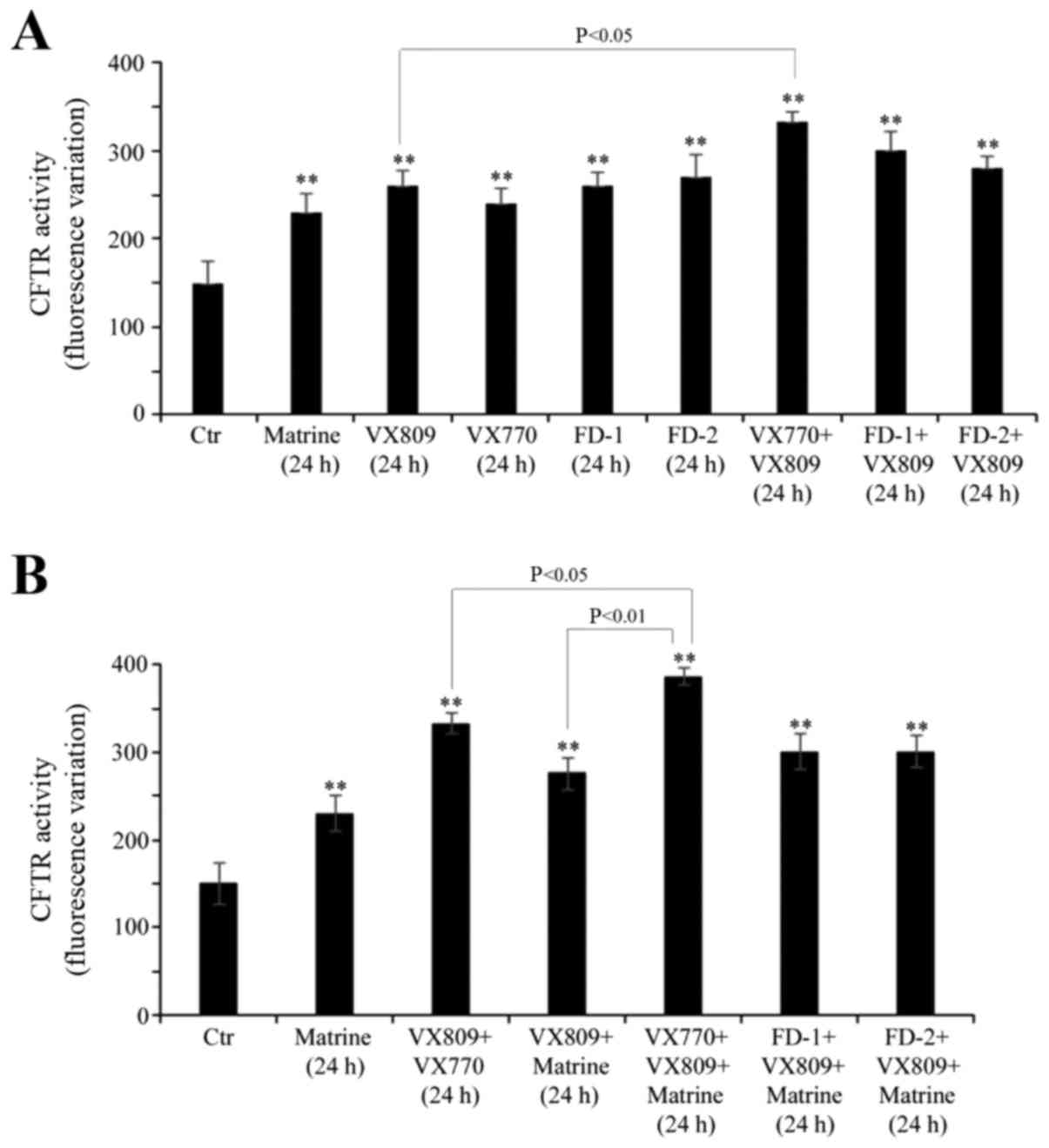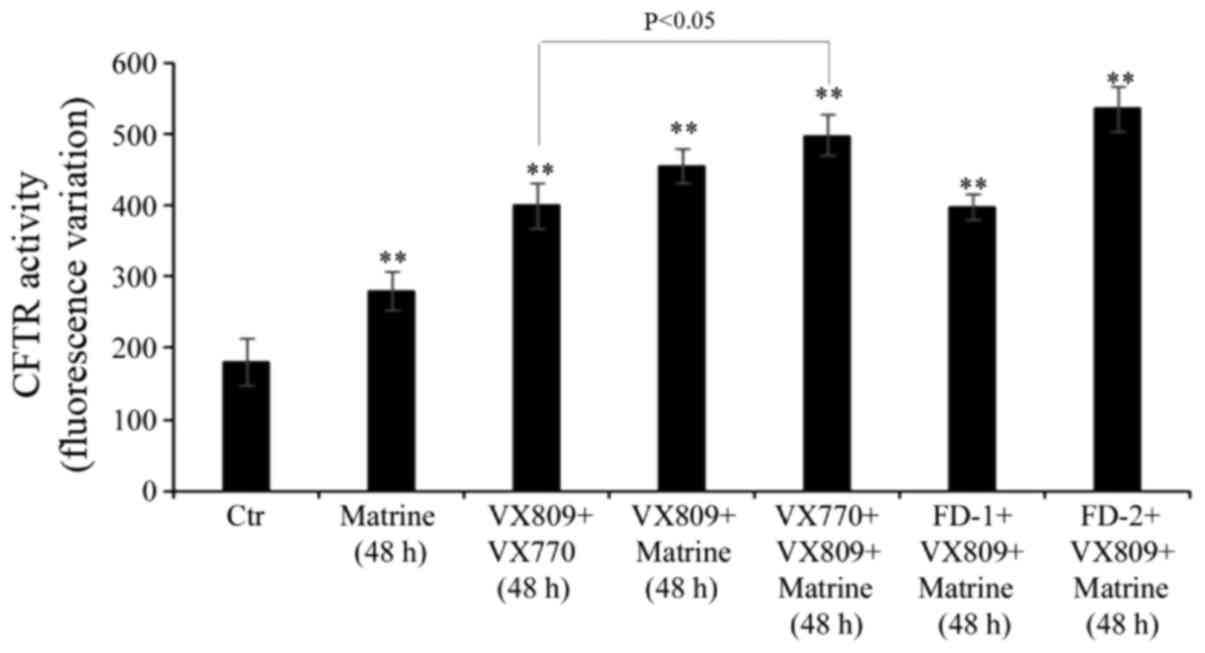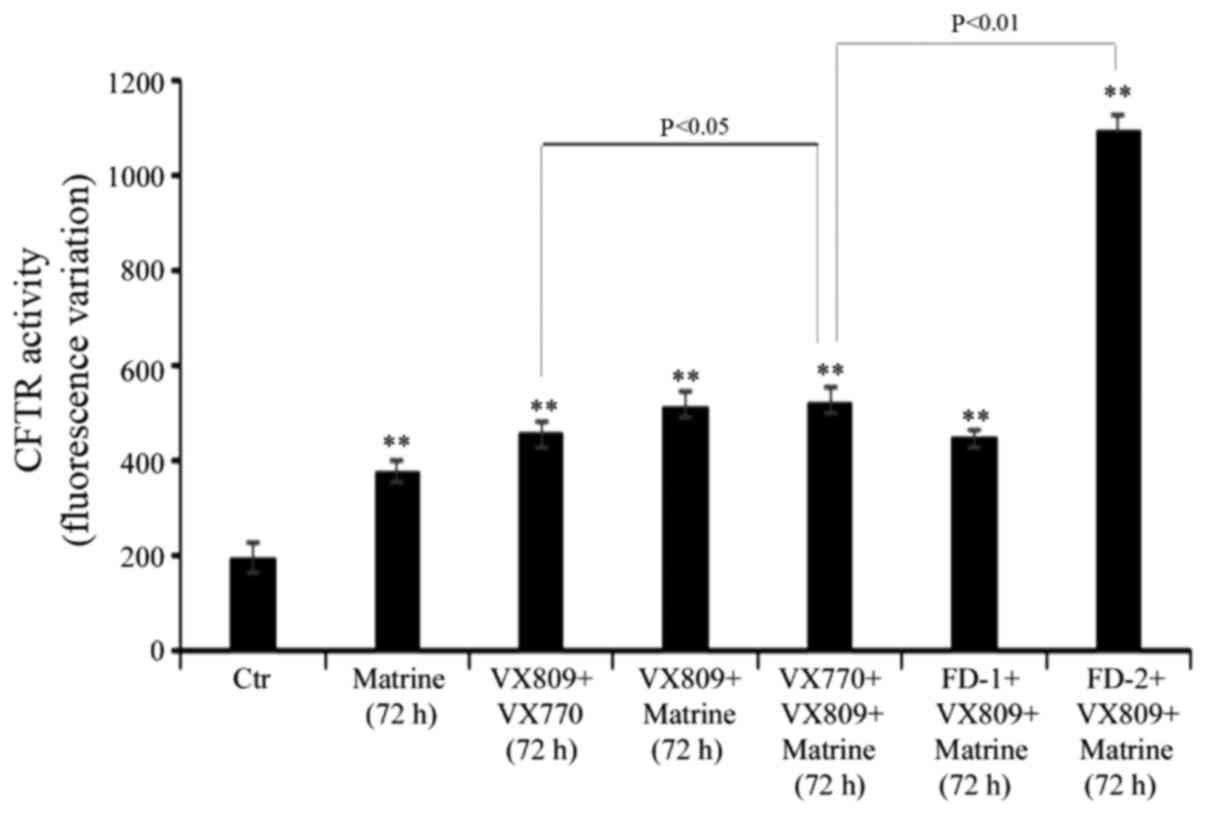Matrine in association with FD‑2 stimulates F508del‑cystic fibrosis transmembrane conductance regulator activity in the presence of corrector VX809
- Authors:
- Published online on: October 6, 2017 https://doi.org/10.3892/mmr.2017.7736
- Pages: 8849-8853
-
Copyright: © Marengo et al. This is an open access article distributed under the terms of Creative Commons Attribution License.
Abstract
Introduction
Cystic fibrosis (CF) is an autosomal recessive genetic disorder caused by mutations of the gene that encodes the cystic fibrosis transmembrane conductance regulator (CFTR) protein (1). This protein is a chloride (or bicarbonate)-conducting anion channel expressed on the membrane of epithelial cells of the lung, intestines and pancreas, which modulates electrolytic exchange. Therefore, mutations in CFTR, leading to altered ion transport, induce a progressive deterioration of the target organs and, consequently, premature mortality of patients (2). CFTR mutations may induce alterations in maturation, subcellular localization (trafficking) and activity (gating) of the CFTR protein (3,4). The predominant CFTR mutation is termed Phe508del (F508del), and results in severely impaired protein maturation with a consequent alteration of CFTR membrane translocation (5,6). However, in the case that the F508del-CFTR is able to reach the plasma membrane, it exhibits reduced activity and stability in the membrane, in addition to a greater tendency towards degradation by the ubiquitin/proteasome system (7,8).
Research has primarily focused on the identification and development of modulators that are able to resolve gating and trafficking problems (9). The ‘corrector’ acts on trafficking and promotes CFTR membrane localization (10,11) while the ‘potentiator’ acts on gating and leads to an increase in CFTR activity (12). Therefore, any therapy should be designed by choosing the most appropriate modulator which is able to target the specific mutation. However, in patients with F508del-CFTR, it has been demonstrated that treatment with a potentiator is ineffective, since it is unable to induce CFTR maturation and membrane translocation. Therefore, in these patients, the co-administration of a corrector and a potentiator is necessary to allow for the almost complete repair of CFTR trafficking and gating (13).
At present, there are two molecules which are frequently used: The potentiator VX770 (ivacaftor) and the corrector VX809 (lumacaftor). Recently, the use of Orkambi®, which is a combination of VX770 and VX809, was approved (3). However, though an improvement in the quality of life of patients treated with the Orkambi was observed, the drug induced a modest improvement in lung function (14). This limited effect may be due to an inhibitory action exerted by VX770 on VX809 (15). In order to overcome this problem, research is focusing on the analysis of natural molecules that may resolve the problem at its origin; among them, matrine, an alkaloid extracted from roots of Sophora flavescens, appears to provide promising results. In particular, matrine, by interacting with the heat shock cognate (HSC)/heat shock 70 kDa protein 1A (HSP70) chaperone system, led to an increase in F508del-CFTR membrane localization (16), and the corrector activity of matrine was observed at high doses (0.4–0.8 mM) which may be toxic for long-term treatment of patients with CF.
The aim of the present study was to investigate whether lower concentrations (30 µM) of matrine (PubChem CID: 91466) may be able to render more effective the action of the known corrector VX809 (PubChem CID: 16678941) and the potentiator VX770 (PubChem CID: 16220172), in addition to that of two dihydropyridines, FD-1 (F508act-05) (17) and FD-2, the latter being a newly-synthesized compound. The use of dihydropyridines may be advantageous, since these molecules were established as potentiators with notable activity, simple synthesis and a low production cost, by Pedemonte et al (18), Cateni et al (19) and Giampieri et al (20). Due to the cited interference between VX770 and VX809, it was deemed noteworthy to investigate the behavior of this class of potentiators, coupled with the corrector VX809. Therefore, FD-1, a compound with a moderate level of activity against FD-2, was selected. A previous study on asymmetrical dihydropyridines demonstrated the ability of the benzyl group to maximize potentiator activity (20), which provided the basis for the analysis of a newly-synthesized dihydropyridine (FD-2) bearing two benzyl groups at the ester level.
Materials and methods
Cell culture and treatments
Fischer rat thyroid (FRT) cells, stably transfected with F508del-CFTR and yellow fluorescent protein (YFP), were provided by Dr L.J. Galietta (G. Gaslini Institute, Genoa, Italy). The co-expressed YFP acts as a halide sensitive dye that may be utilized to measure the anion permeability of CFTR (18,21). Cells were cultured in Coon's modified F-12 medium (Sigma-Aldrich; Merck KGaA, Darmstadt, Germany) supplemented with 5% fetal bovine serum (EuroClone SpA, Pero, Italy), 2 mM glutamine (EuroClone SpA), 1% penicillin/streptomycin (EuroClone SpA), 0.8 mg/ml zeocin (Thermo Fisher Scientific, Inc., Waltham, MA, USA) and 1.5 mg/ml G418 (Sigma-Aldrich; Merck KGaA). Cells were plated (1×105 cells/well) into 96-well microplates and treated with matrine (30 µM; Sigma-Aldrich; Merck KGaA) for 24, 48 and 72 h. In a series of experiments, cells were co-treated for 24, 48 or 72 h with 2 µM VX809 (Selleck Chemicals, Houston, TX, USA) and/or with one of three potentiators: 10 µM VX770 (Selleck Chemicals), 10 µM FD-1 and 10 µM FD-2 (both synthesized in the Department of Pharmacy, University of Genoa, Genoa, Italy).
The stock solutions of all tested compounds were prepared in dimethyl sulfoxide (DMSO) and pilot studies demonstrated that the final DMSO concentration did not alter any of the cellular responses analyzed. In addition, under all conditions, the data obtained in treated cells was compared to DMSO-treated cells (Ctr). The pilot study was performed by treating cells with the highest dose of DMSO used to dissolve all tested compounds for 24, 48 and 72 h. Then, cell viability was evaluated by MTT assay.
FD-2 was synthesized following the procedure described in Cateni et al (19). Benzyl acetoacetate, 4-isopropylbenzaldehyde and ammonia were dissolved in isopropanol and refluxed for 4 h. Subsequently, the crude product was subjected to chromatography on a silica gel (n-hexane/diethylether) and the residue was crystallized from cyclohexane. Yield, 25%; melting point 107–109°C. 1H-nuclear magnetic resonance (CDCl3): δ1.22–1.27 [m, 6H, CH (CH3)2]; 2.34 (s, 6H, CH3); 2.80 [m, 1H, CH (CH3)2]; 5.09–5.13 (m, 5H, 2CH2 + H-4); 5.78 (br s, 1H, NH); and 7.04–7.32 (m, 14H Ar). Infrared (KBr): 3439 (NH); and 1691 (CO) cm−1. Combustion elemental analysis calculated for C32H33NO4: C 77.55, H 6.71, N 2.83; observed: C 77.57, H 6.40, N 2.97 (Fig. 1).
MTT assay
Cell viability was determined using MTT (Sigma-Aldrich; Merck KGaA) staining (22,23). Cells were seeded into 96-well microplates (Corning Incorporated, Corning, NY, USA) at a density of 1×105 cells/well and treated as described above. Subsequently, the cells were incubated with 0.5 mg/ml MTT for 3 h at 37°C. Following incubation, the supernatant was discarded, the insoluble formazan precipitates were dissolved in HCl (0.1 M in isopropanol) and the absorbance at 570/630 nm was recorded using a microplate reader (EL-808; BioTek Instruments Inc., Winooski, VT, USA).
Fluorescence assay
CFTR activity was determined using a fluorescence assay (18,21,24). Cells were plated (100,000 cells/well) into black 96-well microplates with clear plastic bottoms (Corning Incorporated). Following treatment as described above, cells were washed with PBS (137 mM NaCl, 2.7 mM KCl, 8.1 mM Na2HPO4, 1.5 mM KH2PO4, 1 mM CaCl2 and 0.5 mM MgCl2; pH 7.4) and stimulated for 20 min with 20 µM forskolin. Microplates were subsequently transferred to a microplate reader (TECAN Infinite® F200 PRO; Tecan Group, Ltd., Männedorf, Switzerland) equipped with excitation (485±20 nm) and emission (535±25 nm) filters. Each assay consisted of a continuous 14 sec fluorescence reading with 2 sec prior to and 12 sec following the injection of 165 µl iodide-containing PBS (PBS with Cl− replaced with I−). The I− influx rate was evaluated by calculating the variation of fluorescence intensity prior to and following the I− injection.
Data analysis
Results are expressed as the mean ± standard error of the mean from at least three independent experiments. The statistical significance of any parametric differences among the sets of experimental data was evaluated using one-way analysis of variance and Dunnett's test for multiple comparisons. GraphPad Prism software (version 4; GraphPad Software, Inc., La Jolla, CA, USA) was used for analysis. P<0.05 was considered to indicate a statistically significant difference.
Results
Treatment with matrine, VX809 or potentiators (VX770, FD-1 and FD-2), alone or in combination, does not affect the via-bility of F508del-CFTR FRT cells
F508del-CFTR FRT cells were exposed for 24, 48 and 72 h to matrine, VX809, VX770, FD-1 and FD-2, alone or in combination, and MTT analysis revealed that none of the treatments was cytotoxic (Fig. 2).
Treatment with matrine alone, and in combination with VX809 plus VX770, is able to stimulate CFTR activity
As exhibited in Fig. 3A, matrine alone stimulated the activity of mutant CFTR by 53% compared with untreated cells, which was a similar result to that observed when the cells were treated with the other compounds individually. In addition, a 24-h VX809/VX770 co-treatment stimulated the effect of VX809 on CFTR activity by 30% (Fig. 3A).
In order to evaluate whether matrine was able to increase the VX809-induced CFTR activity, other experiments were performed by treating the cells for 24 h with a combination of matrine, VX809 and/or potentiators. As illustrated in Fig. 3B, all the combinations tested were able to stimulate CFTR activity by 80–100% compared with control cells. In addition, the presence of matrine further stimulated the effect of the VX809/VX770 combination on CFTR activity by 16%.
Matrine co-treatment increases the effect of VX809 in combination with VX770
Following 48 h of treatment, the VX809/VX770 combination stimulated the activity of mutant CFTR by 120% compared with control cells, and the co-administration of matrine further increased CFTR activity by 25% (Fig. 4). Notably, the co-treatment of FD-1 with matrine/VX809 had a similar effect to that observed in VX809/VX770-treated cells (Fig. 4). FD-2, in combination with matrine/VX809, stimulated the activity of mutant CFTR with a similar efficiency to matrine/VX770/VX809 (Fig. 4).
Matrine-FD-2 co-treatment markedly increases the effect of VX809
Following 72 h of treatment, the combination of matrine with FD-2 and VX809 stimulated mutant CFTR activity by 450% compared with control cells (Fig. 5). Notably, when VX770 was administered in place of FD-2, the rate of mutant CFTR activity was increased only by 165% compared with that observed in untreated cells (Fig. 5). However, it is necessary to note that, as already observed at 48 h, the VX809/VX770 combination stimulated the activity of mutant CFTR by 130% (Fig. 5) and the co-administration of matrine further increased CFTR activity by 15% (Fig. 5).
In addition, the effect of FD-1 co-treatment with matrine and VX-809 produced similar effects to those observed in cells co-treated with VX770 instead of FD-1 (Fig. 5).
Discussion
CF is the most common autosomal recessive disease with a fatal outcome (8). The disease is characterized by alterations in the maturation and function of CFTR, a channel protein responsible for anion transport, particularly chloride ions. To date, >2,000 CFTR mutations have been identified, and it has been observed that consequent electrolyte imbalances lead to a progressive loss of function of a number of organs, resulting in the mortality (25). Considering the high incidence of this disease, it has become necessary to identify novel therapies and to improve the effectiveness of existing treatments. The current therapeutic approaches are primarily based on the use of antibiotics, pancreatic enzymes, anti-inflammatory drugs and mucolytics which, while improving the symptoms, do not alter the outcome of the pathology.
However, novel pharmacotherapeutic approaches are based on the use of correctors and/or potentiators. Among the known correctors, VX809 (lumacaftor) is presently used to treat patients with the F508del-CFTR mutation (a class II mutation) in which there is an alteration in CFTR trafficking (10), and acts by inducing CFTR protein maturation in the endoplasmic reticulum/Golgi apparatus and by increasing CFTR translocation to the cell membrane. Potentiators are able to counteract gating defects due to mutations, including G551D (a class III mutation). The F508del-CFTR protein, though able to translocate to the plasma membrane, is not functionally active (12), while VX770 (ivacaftor), acting as a potentiator, is able to stimulate the activity of the mutant CFTR when the mutation is class III.
In order to improve the efficacy of the therapy, a novel approach is to combine a corrector with a potentiator, and, among the new drugs, Orkambi (which consists of the combination of VX809 that facilitates F508del-CFTR maturation, and VX770 which improves its function) was the first approved therapy to treat homozygous patients for the F508del-CFTR mutation (26). In these patients, the use of a potentiator alone is ineffective as it does not stimulate CFTR trafficking, only stimulating the activity of the CFTR present in the cell membrane. However, a previous study has demonstrated that this combined approach reduces the efficacy of VX809 (15). These previous results are in line with a recent study reporting that, although Orkambi induces an improvement in symptomatology, long-term treatment leads to a progressive reduction of its pharmacological efficacy, attributed to the VX770-mediated destabilization of VX809-rescued F508del-CFTR (15). In order to reduce this inhibitory effect, other molecules with a different mechanism of action compared with that of currently-used drugs are being evaluated.
Matrine, a natural molecule used in traditional Chinese medicine, may be effective in reducing the aforementioned inhibitory effect. Matrine, interacting with the HSC/HSP70 chaperone system, downregulates the expression of HSC70 and increases the protein levels of F508del-CFTR (16). Therefore, the results of the present study are promising. Matrine was able to stimulate CFTR activity, further increase the functionality of the channel in the presence of VX809 and moderately affect the action of VX77/VX809. In particular, this action of matrine was observed at 72 h and may be due to the fact that this compound requires time to stimulate CFTR activity. The inhibitory effect of VX770 on VX809, not detectable at 24 h, was evident at 48 h and at 72 h. In addition, the results of the present study suggested that matrine may partially counteract the inhibitory effect of VX770 on VX809 under all the time conditions assayed.
Previous research has led to the development and study of novel potentiators and, among those tested, the results of the present study demonstrated that FD-2, in the presence of matrine, was able to markedly increase the CFTR activity induced by VX809. This effect was time-dependent and was particularly evident at 72 h. The different degrees of action of matrine on VX770/VX809 and FD2/VX809 is likely to be due to the different mechanisms of action of the two potentiators. This hypothesis will be matter of investigation in our future studies.
In conclusion, the results of the present study proposed FD-2 to be a novel and possibly more efficacious potentiator, compared with VX770. Although it is necessary to perform these treatments on other cellular models and to also validate these data in in vivo systems, the present results may be useful in proposing novel and more effective therapeutic approaches in CF.
Acknowledgements
The authors of the present study would like to acknowledge Mr. Giuseppe Catalano (DIMES, University of Genoa) for technical assistance and Ms. Suzanne Patten for language editing. The present study was supported by grants from Genoa University (B. Marengo) and funds from the Italian Cystic Fibrosis Research Foundation, Verona, Italy (M. Mazzei).
Glossary
Abbreviations
Abbreviations:
|
CF |
cystic fibrosis |
|
CFTR |
cystic fibrosis transmembrane conductance regulator |
|
FRT |
Fischer rat thyroid |
References
|
Rommens JM, Iannuzzi MC, Kerem B, Drumm ML, Melmer G, Dean M, Rozmahel R, Cole JL, Kennedy D, Hidaka N, et al: Identification of the cystic fibrosis gene: Chromosome walking and jumping. Science. 245:1059–1065. 1989. View Article : Google Scholar : PubMed/NCBI | |
|
Corradi V, Vergani P and Tieleman DP: Cystic fibrosis transmembrane conductance regulator (CFTR): Closed and open state channel models. J Biol Chem. 290:22891–22906. 2015. View Article : Google Scholar : PubMed/NCBI | |
|
Elborn JS: Cystic fibrosis. Lancet. 388:2519–2531. 2016. View Article : Google Scholar : PubMed/NCBI | |
|
Caputo A, Hinzpeter A, Caci E, Pedemonte N, Arous N, Di Duca M, Zegarra-Moran O, Fanen P and Galietta LJ: Mutation-specific potency and efficacy of cystic fibrosis transmembrane conductance regulator chloride channel potentiators. J Pharmacol Exp Ther. 330:783–791. 2009. View Article : Google Scholar : PubMed/NCBI | |
|
Cheng SH, Gregory RJ, Marshall J, Paul S, Souza DW, White GA, O'Riordan CR and Smith AE: Defective intracellular transport and processing of CFTR is the molecular basis of most cystic fibrosis. Cell. 63:827–834. 1990. View Article : Google Scholar : PubMed/NCBI | |
|
Dalemans W, Barbry P, Champigny G, Jallat S, Dott K, Dreyer D, Crystal RG, Pavirani A, Lecocq JP and Lazdunski M: Altered chloride ion channel kinetics associated with the delta F508 cystic fibrosis mutation. Nature. 354:526–528. 1991. View Article : Google Scholar : PubMed/NCBI | |
|
Riordan JR: CFTR function and prospects for therapy. Annu Rev Biochem. 77:701–726. 2008. View Article : Google Scholar : PubMed/NCBI | |
|
Pedemonte N and Galietta LJ: Pharmacological Correctors of Mutant CFTR Mistrafficking. Front Pharmacol. 3:1752012. View Article : Google Scholar : PubMed/NCBI | |
|
Nieddu E, Pollarolo B, Mazzei MT, Anzaldi M, Schenone S, Pedemonte N, Pesce E, Galietta LJ and Mazzei M: The search for a common structural moiety among selected pharmacological correctors of the mutant CFTR chloride channel. Futur Med Chem. 6:1857–1868. 2014. View Article : Google Scholar | |
|
Wang X, Venable J, LaPointe P, Hutt DM, Koulov AV, Coppinger J, Gurkan C, Kellner W, Matteson J, Plutner H, et al: Hsp90 cochaperone Aha1 downregulation rescues misfolding of CFTR in cystic fibrosis. Cell. 127:803–815. 2006. View Article : Google Scholar : PubMed/NCBI | |
|
Mu TW, Ong DS, Wang YJ, Balch WE, Yates JR III, Segatori L and Kelly JW: Chemical and biological approaches synergize to ameliorate protein-folding diseases. Cell. 134:769–781. 2008. View Article : Google Scholar : PubMed/NCBI | |
|
Zegarra-Moran O, Monteverde M, Galietta LJ and Moran O: Functional analysis of mutations in the putative binding site for cystic fibrosis transmembrane conductance regulator potentiators. Interaction between activation and inhibition. J Biol Chem. 282:9098–9104. 2007. View Article : Google Scholar : PubMed/NCBI | |
|
Sondo E, Tomati V, Caci E, Esposito AI, Pfeffer U, Pedemonte N and Galietta LJ: Rescue of the mutant CFTR chloride channel by pharmacological correctors and low temperature analyzed by gene expression profiling. Am J Physiol Cell Physiol. 301:C872–C885. 2011. View Article : Google Scholar : PubMed/NCBI | |
|
Langron E, Simone MI, Delalande CM, Reymond JL, Selwood DL and Vergani P: Improved fluorescence assays to measure the defects associated with F508del-CFTR allow identification of new active compounds. Br J Pharmacol. 174:525–539. 2017. View Article : Google Scholar : PubMed/NCBI | |
|
Bali V, Lazrak A, Guroji P, Matalon S and Bebok Z: Mechanistic approaches to improve correction of the most common disease-causing mutation in cystic fibrosis. PLoS One. 11:e01558822016. View Article : Google Scholar : PubMed/NCBI | |
|
Basile A, Pascale M, Franceschelli S, Nieddu E, Mazzei MT, Fossa P, Turco MC and Mazzei M: Matrine modulates HSC70 levels and rescues DeltaF508-CFTR. J Cell Physiol. 227:3317–3323. 2012. View Article : Google Scholar : PubMed/NCBI | |
|
Verkman A, LJ V Galietta and Guy RK: Compounds having activity in increasing ion transport by mutant-cftr and uses thereof. US Patent WO2004110352. Filed July 14, 2004; issued December 23. 2004. | |
|
Pedemonte N, Diena T, Caci E, Nieddu E, Mazzei M, Ravazzolo R, Zegarra-Moran O and Galietta LJ: Antihypertensive 1,4-dihydropyridines as correctors of the cystic fibrosis transmembrane conductance regulator channel gating defect caused by cystic fibrosis mutations. Mol Pharmacol. 68:1736–1746. 2005.PubMed/NCBI | |
|
Cateni F, Zacchigna M, Pedemonte N, Galietta LJ, Mazzei MT, Fossa P, Giampieri M and Mazzei M: Synthesis of 4-thiophen-2′-yl-1,4-dihydropyridines as potentiators of the CFTR chloride channel. Bioorg Med Chem. 17:7894–7903. 2009. View Article : Google Scholar : PubMed/NCBI | |
|
Giampieri M, Vanthuyne N, Nieddu E, Mazzei MT, Anzaldi M, Pedemonte N, Galietta LJ, Roussel C and Mazzei M: Asymmetric 4-Aryl-1,4-dihydropyridines potentiate mutant cystic fibrosis transmembraneconductance regulator (CFTR). Chem Med Chem. 7:1799–1807. 2012. View Article : Google Scholar : PubMed/NCBI | |
|
Galietta LJ, Haggie PM and Verkman AS: Green fluorescent protein-based halide indicators with improved chloride and iodide affinities. FEBS Lett. 499:220–224. 2001. View Article : Google Scholar : PubMed/NCBI | |
|
Marengo B, De Ciucis C, Ricciarelli R, Passalacqua M, Nitti M, Zingg JM, Marinari UM, Pronzato MA and Domenicotti C: PKCdelta sensitizes neuroblastoma cells to L-buthionine-sulfoximine and etoposide inducing reactive oxygen species overproduction and DNA damage. PLoS One. 6:e146612011. View Article : Google Scholar : PubMed/NCBI | |
|
Colla R, Izzotti A, De Ciucis C, Fenoglio D, Ravera S, Speciale A, Ricciarelli R, Furfaro AL, Pulliero A, Passalacqua M, et al: Glutathione-mediated antioxidant response and aerobic metabolism: two crucial factors involved in determining the multi-drug resistance of high-risk neuroblastoma. Oncotarget. 7:70715–70737. 2016.PubMed/NCBI | |
|
Galietta LV, Jayaraman S and Verkman AS: Cell-based assay for high-throughput quantitative screening of CFTR chloride transport agonists. Am J Physiol Cell Physiol. 281:C1734–C1742. 2001.PubMed/NCBI | |
|
McAuley DF and Elborn JS: Cystic fibrosis: Basic science. Paediatr Respir Rev. 1:93–100. 2000.PubMed/NCBI | |
|
Deeks ED: Lumacaftor/Ivacaftor: A review in cystic fibrosis. Drugs. 76:1191–1201. 2016. View Article : Google Scholar : PubMed/NCBI |



